一、JDK8新特性(Stream流)
接下来学习一个全新的知识,叫做Stream流(也叫Stream API)。它是从JDK8以后才有的一个新特性,是专业用于对集合或者数组进行便捷操作的。有多方便呢?我们用一个案例体验一下,然后再详细学习。
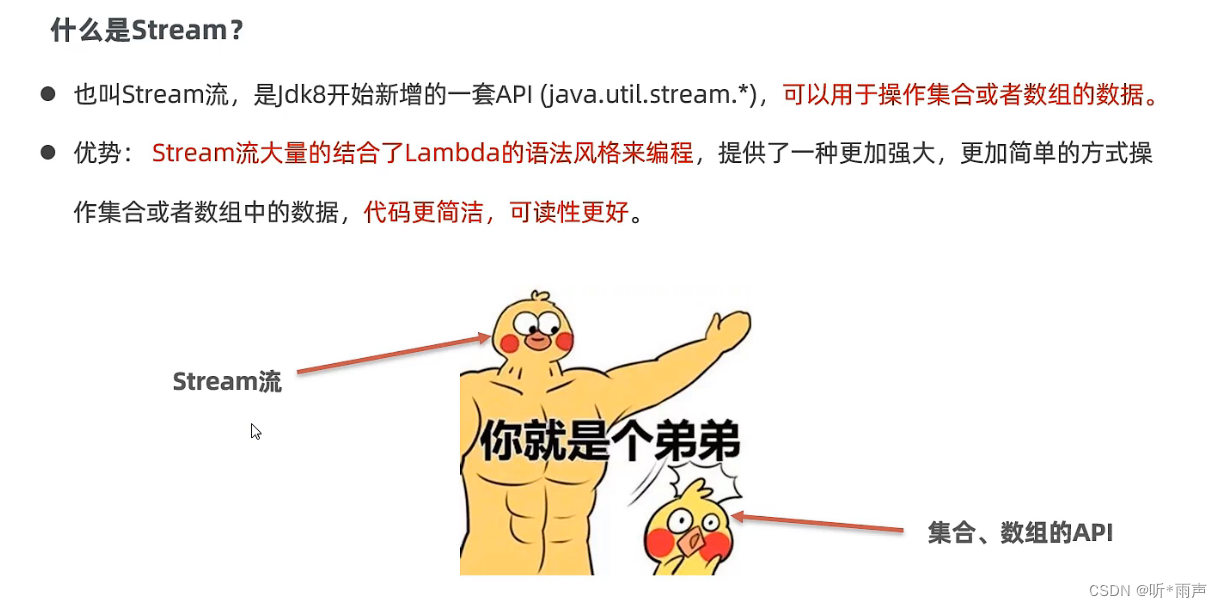
1.1 Stream流体验
案例需求:有一个List集合,元素有"张三丰","张无忌","周芷若","赵敏","张强",找出姓张,且是3个字的名字,存入到一个新集合中去。
List<String> names = new ArrayList<>();
Collections.addAll(names, "张三丰","张无忌","周芷若","赵敏","张强");
System.out.println(names);
- 用传统方式来做,代码是这样的
// 找出姓张,且是3个字的名字,存入到一个新集合中去。
List<String> list = new ArrayList<>();
for (String name : names) {if(name.startsWith("张") && name.length() == 3){list.add(name);}
}
System.out.println(list);
- 用Stream流来做,代码是这样的(ps: 是不是想流水线一样,一句话就写完了)
List<String> list2 = names.stream().filter(s -> s.startsWith("张")).filter(a -> a.length()==3).collect(Collectors.toList());
System.out.println(list2);
先不用知道这里面每一句话是什么意思,具体每一句话的含义,待会再一步步学习。现在只是体验一下。
学习Stream流我们接下来,会按照下面的步骤来学习。
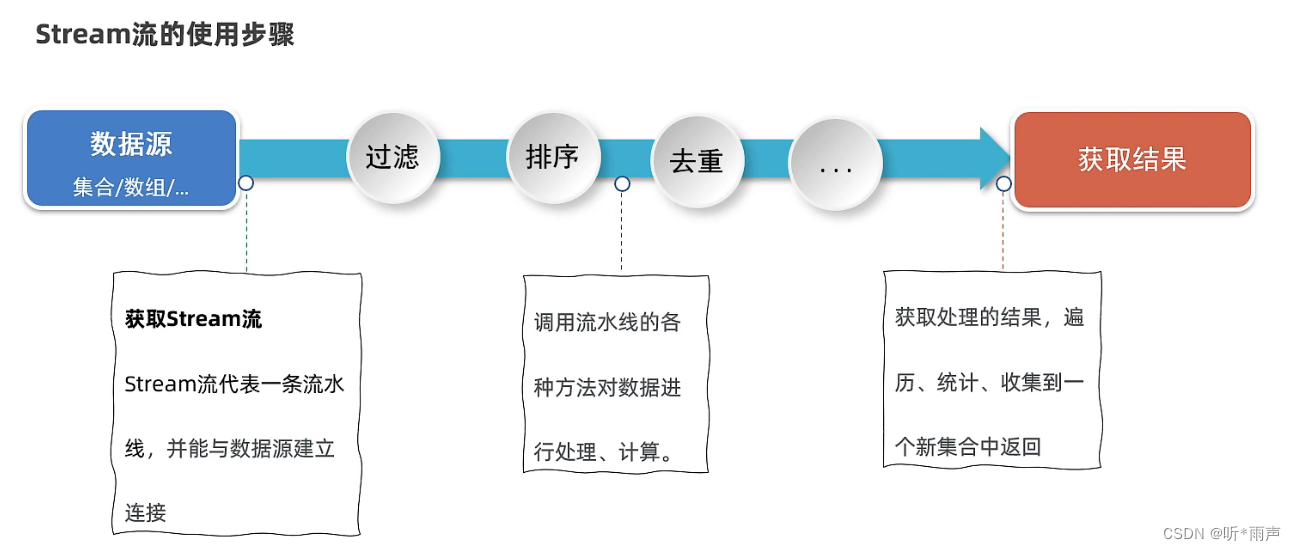
1.2 Stream流的创建
好,接下来我们正式来学习Stream流。先来学习如何创建Stream流、或者叫获取Stream流。
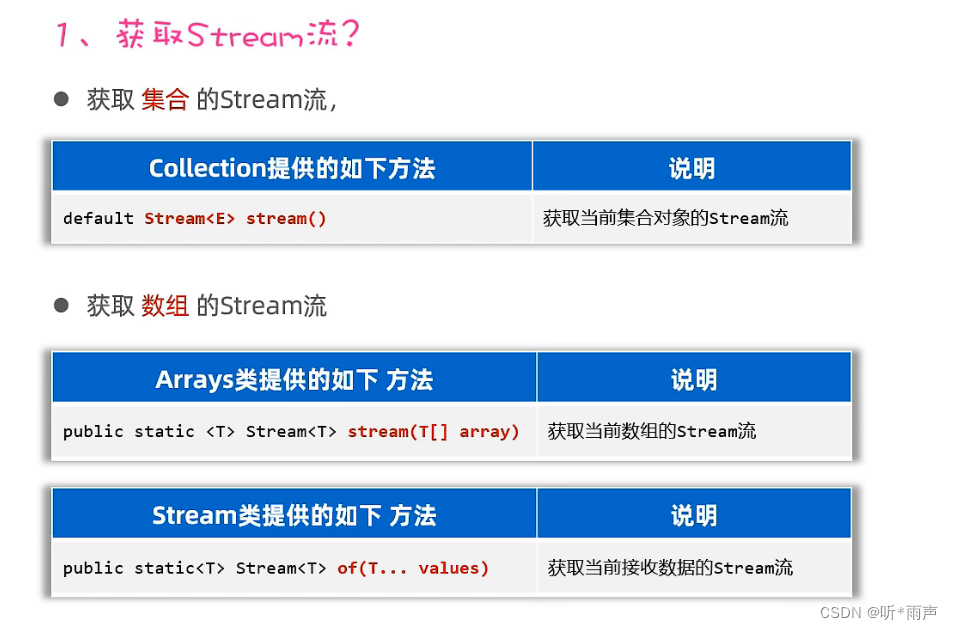
主要掌握下面四点:1、如何获取List集合的Stream流?2、如何获取Set集合的Stream流?3、如何获取Map集合的Stream流?4、如何获取数组的Stream流?
直接上代码演示
/*** 目标:掌握Stream流的创建。*/
public class StreamTest2 {public static void main(String[] args) {// 1、如何获取List集合的Stream流?List<String> names = new ArrayList<>();Collections.addAll(names, "张三丰","张无忌","周芷若","赵敏","张强");Stream<String> stream = names.stream();// 2、如何获取Set集合的Stream流?Set<String> set = new HashSet<>();Collections.addAll(set, "刘德华","张曼玉","蜘蛛精","马德","德玛西亚");Stream<String> stream1 = set.stream();stream1.filter(s -> s.contains("德")).forEach(s -> System.out.println(s));// 3、如何获取Map集合的Stream流?Map<String, Double> map = new HashMap<>();map.put("古力娜扎", 172.3);map.put("迪丽热巴", 168.3);map.put("马尔扎哈", 166.3);map.put("卡尔扎巴", 168.3);Set<String> keys = map.keySet();Stream<String> ks = keys.stream();Collection<Double> values = map.values();Stream<Double> vs = values.stream();Set<Map.Entry<String, Double>> entries = map.entrySet();Stream<Map.Entry<String, Double>> kvs = entries.stream();kvs.filter(e -> e.getKey().contains("巴")).forEach(e -> System.out.println(e.getKey()+ "-->" + e.getValue()));// 4、如何获取数组的Stream流?String[] names2 = {"张翠山", "东方不败", "唐大山", "独孤求败"};Stream<String> s1 = Arrays.stream(names2);Stream<String> s2 = Stream.of(names2);}
}1.3 Stream流中间方法
中间方法指的是:调用完方法之后其结果是一个新的Stream流,于是可以继续调用方法,这样一来就可以支持链式编程(或者叫流式编程)。
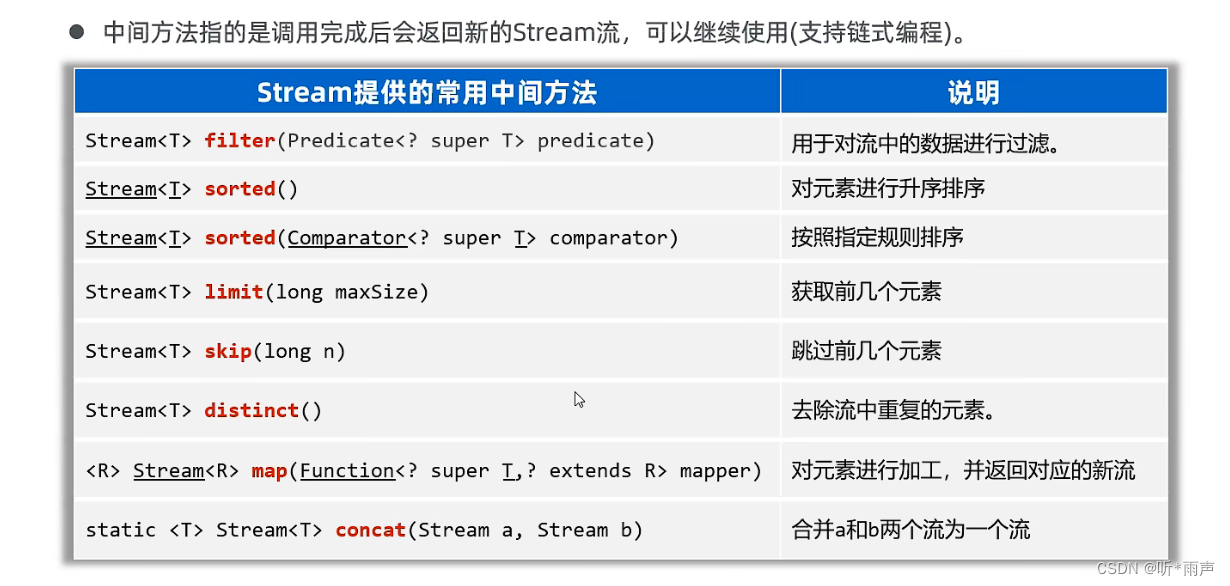
话不多说,直接上代码演示
/*** 目标:掌握Stream流提供的常见中间方法。*/
public class StreamTest3 {public static void main(String[] args) {List<Double> scores = new ArrayList<>();Collections.addAll(scores, 88.5, 100.0, 60.0, 99.0, 9.5, 99.6, 25.0);// 需求1:找出成绩大于等于60分的数据,并升序后,再输出。scores.stream().filter(s -> s >= 60).sorted().forEach(s -> System.out.println(s));List<Student> students = new ArrayList<>();Student s1 = new Student("蜘蛛精", 26, 172.5);Student s2 = new Student("蜘蛛精", 26, 172.5);Student s3 = new Student("紫霞", 23, 167.6);Student s4 = new Student("白晶晶", 25, 169.0);Student s5 = new Student("牛魔王", 35, 183.3);Student s6 = new Student("牛夫人", 34, 168.5);Collections.addAll(students, s1, s2, s3, s4, s5, s6);// 需求2:找出年龄大于等于23,且年龄小于等于30岁的学生,并按照年龄降序输出.students.stream().filter(s -> s.getAge() >= 23 && s.getAge() <= 30).sorted((o1, o2) -> o2.getAge() - o1.getAge()).forEach(s -> System.out.println(s));// 需求3:取出身高最高的前3名学生,并输出。students.stream().sorted((o1, o2) -> Double.compare(o2.getHeight(), o1.getHeight())).limit(3).forEach(System.out::println);System.out.println("-----------------------------------------------");// 需求4:取出身高倒数的2名学生,并输出。 s1 s2 s3 s4 s5 s6students.stream().sorted((o1, o2) -> Double.compare(o2.getHeight(), o1.getHeight())).skip(students.size() - 2).forEach(System.out::println);// 需求5:找出身高超过168的学生叫什么名字,要求去除重复的名字,再输出。students.stream().filter(s -> s.getHeight() > 168).map(Student::getName).distinct().forEach(System.out::println);// distinct去重复,自定义类型的对象(希望内容一样就认为重复,重写hashCode,equals)students.stream().filter(s -> s.getHeight() > 168).distinct().forEach(System.out::println);Stream<String> st1 = Stream.of("张三", "李四");Stream<String> st2 = Stream.of("张三2", "李四2", "王五");Stream<String> allSt = Stream.concat(st1, st2);allSt.forEach(System.out::println);}
}
1.4 Stream流终结方法
最后,我们再学习Stream流的终结方法。这些方法的特点是,调用完方法之后,其结果就不再是Stream流了,所以不支持链式编程。
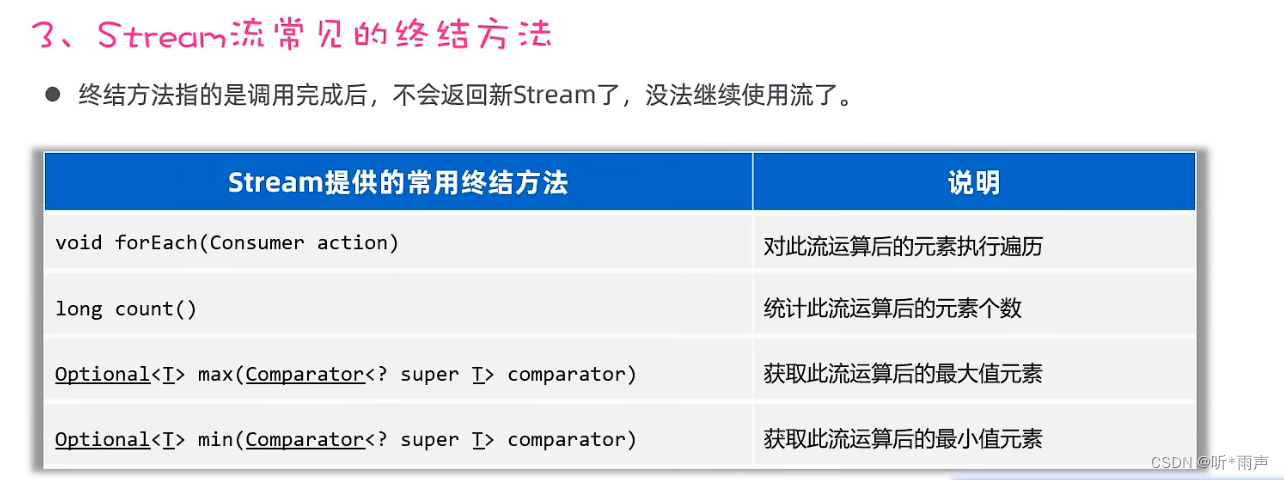
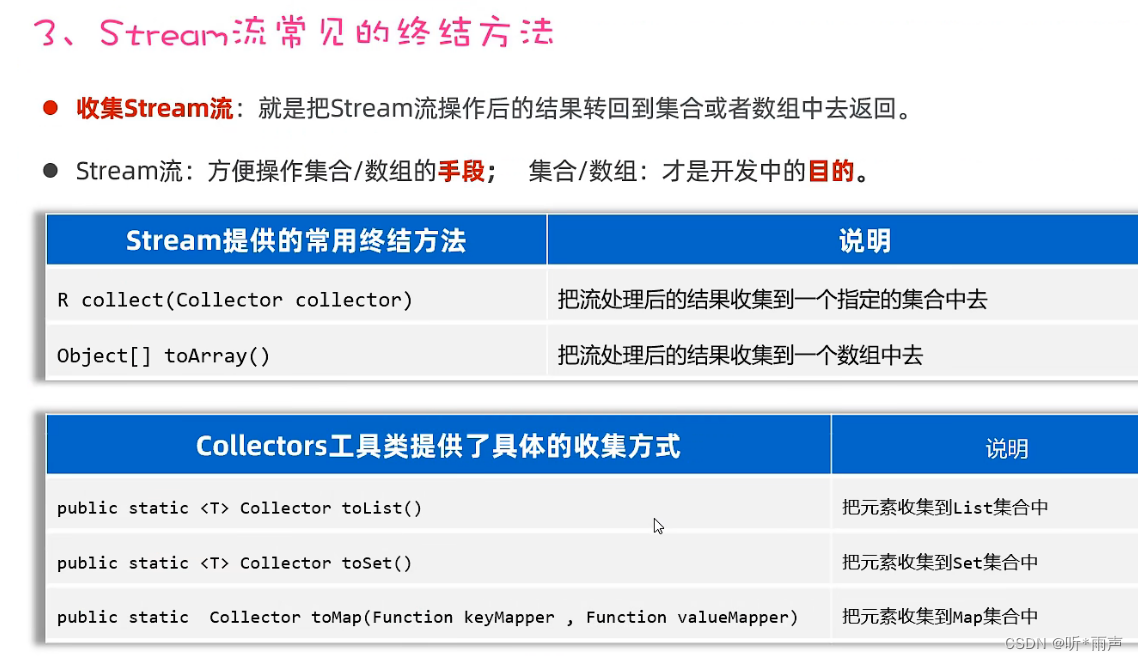
话不多说,直接上代码
/*** 目标:Stream流的终结方法*/
public class StreamTest4 {public static void main(String[] args) {List<Student> students = new ArrayList<>();Student s1 = new Student("蜘蛛精", 26, 172.5);Student s2 = new Student("蜘蛛精", 26, 172.5);Student s3 = new Student("紫霞", 23, 167.6);Student s4 = new Student("白晶晶", 25, 169.0);Student s5 = new Student("牛魔王", 35, 183.3);Student s6 = new Student("牛夫人", 34, 168.5);Collections.addAll(students, s1, s2, s3, s4, s5, s6);// 需求1:请计算出身高超过168的学生有几人。long size = students.stream().filter(s -> s.getHeight() > 168).count();System.out.println(size);// 需求2:请找出身高最高的学生对象,并输出。Student s = students.stream().max((o1, o2) -> Double.compare(o1.getHeight(), o2.getHeight())).get();System.out.println(s);// 需求3:请找出身高最矮的学生对象,并输出。Student ss = students.stream().min((o1, o2) -> Double.compare(o1.getHeight(), o2.getHeight())).get();System.out.println(ss);// 需求4:请找出身高超过170的学生对象,并放到一个新集合中去返回。// 流只能收集一次。List<Student> students1 = students.stream().filter(a -> a.getHeight() > 170).collect(Collectors.toList());System.out.println(students1);Set<Student> students2 = students.stream().filter(a -> a.getHeight() > 170).collect(Collectors.toSet());System.out.println(students2);// 需求5:请找出身高超过170的学生对象,并把学生对象的名字和身高,存入到一个Map集合返回。Map<String, Double> map =students.stream().filter(a -> a.getHeight() > 170).distinct().collect(Collectors.toMap(a -> a.getName(), a -> a.getHeight()));//把什么作为键,把什么作为值System.out.println(map);// Object[] arr = students.stream().filter(a -> a.getHeight() > 170).toArray();Student[] arr = students.stream().filter(a -> a.getHeight() > 170).toArray(len -> new Student[len]);System.out.println(Arrays.toString(arr));}
}




-模块化)





FPGA代码篇)

)





不停机迁移方案)
